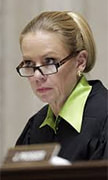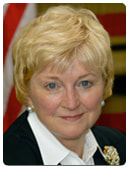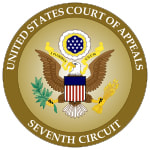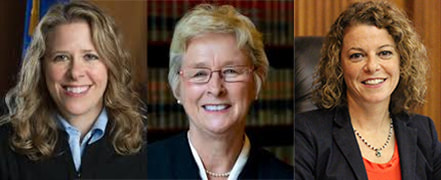 By Margo Kirchner Oral argument on WJI’s challenge to the victims’ rights constitutional amendment known commonly as “Marsy’s Law” is set for 9 a.m. Thursday. The hearing will be conducted virtually, and the public may watch on YouTube using this link: https://www.youtube.com/channel/UC5SDXzrIBTLO0a0I8iz2P9w. Dane County Circuit Judge Frank D. Remington presides over the case. WJI and four individuals allege that the April 2020 ballot question asking voters to approve the amendment to the Wisconsin Constitution was invalid. Attorney Dennis Grzezinski will represent WJI and the other plaintiffs at the hearing. As reported previously, the plaintiffs contend that the ballot question failed to fully and fairly inform the public of the essential components of the amendment, misstated the contents and impact of the proposed amendment, and improperly encompassed more than one subject. Although under Wisconsin Supreme Court cases the Legislature has discretion in formulating a ballot question, the question must nevertheless “reasonably, intelligently, and fairly comprise or have reference to every essential of the amendment” so the public “may be fully informed on the subject” on which they are voting. The plaintiffs contend that, among other things, the amendment struck the state constitution’s only reference to a “fair trial for the defendant,” eliminated a defendant’s right to exclude an alleged victim from the courtroom if necessary for a fair trial, and altered defendants’ rights set forth in other sections of the Wisconsin Constitution or state statutes. Yet the ballot question failed to tell voters of such changes. The plaintiffs argue that the ballot question told voters the amendment would protect a victim’s and an accused’s rights “with equal force,” but the amendment’s actual text permits giving a victim greater protection of rights than an accused receives. Also, the plaintiffs say, the amendment contains more than one subject, requiring separate ballot questions. The Wisconsin Constitution mandates that “if more than one amendment be submitted, they shall be submitted in such manner that the people may vote for or against such amendments separately.” The plaintiffs charge that the amendment created a new category of victims, including roommates or live-in caregivers of deceased individuals, but the ballot question failed to reference that change. The plaintiffs' brief in support of striking th eamendments is here; the state's brief in opposition is here; and the plaintiffs' reply is here.
0 Comments
By Margo Kirchner Criminal law rarely provides justice in cases of police brutality and violence because convictions are so difficult to obtain even with video evidence, according to a Villanova University law school associate dean. “It’s hard to win cases against police officers, and because plaintiffs usually lose, police are not deterred from their bad behavior,” said Teressa Ravenell, who also is a professor at Villanova’s Charles Widger School of Law. Ravenell made her comments during the American Constitution Society’s recent briefing call on police violence and systematic racism in the U.S. legal system. ACS held the call in response to the killing of George Floyd and waves of protest across the country. Ravenell said that federal law allows individuals to sue when their civil rights are violated by government actors, but that law has not prevented police violence either. The law, Section 1983, has become “another example of systematic failure,” she remarked. The statute is “not inherently flawed,” but the U.S. Supreme Court’s interpretation of the statute has caused it to fail, she said. Problematic interpretation of Section 1983 includes the judge-made doctrine of qualified immunity, Ravenell said. The qualified immunity doctrine protects public officials from civil liability unless their conduct violates a clearly established constitutional right about which a reasonable person would have known. The Supreme Court has written that the doctrine protects "all but the plainly incompetent or those who knowingly violate the law” and balances the need to hold public officials accountable when they act irresponsibly with the need to shield them from harassment, distraction, and liability when they perform their duties reasonably.
In a 2018 dissent, however, Justice Sonia Sotomayor wrote that the doctrine “tells officers that they can shoot first and think later, and it tells the public that palpably unreasonable conduct will go unpunished.” The doctrine has recently shielded officers from liability for stealing $225,000 while executing a search warrant, shooting a 10-year-old boy in his backyard while pursuing a suspect, and slamming to the ground a woman who turned to walk away from an officer toward her daughter, rendering the woman unconscious. Ravenell set forth five large hurdles plaintiffs face under current law, which in her view result in continued racist law enforcement. First, the Supreme Court’s Fourth Amendment cases give police officers too much power to stop, investigate, and arrest Black people. Police may legally stop someone if an officer has reasonable suspicion to think that criminal activity is afoot, and that standard can be met when a person acts evasively in a high-crime area. Ravenell called “high-crime area” a “fancy way” of saying poor, Black neighborhoods. As a result, Blacks are more likely to be stopped by police. Further, Blacks are pulled over for traffic violations more than any other group, she said. Second, the Court’s Fourth Amendment cases give police officers too much license to use force. The court has allowed officers to use deadly force when they reasonably believe a person poses an immediate threat of harm to the officer or others, and too often officers view unarmed Black men as threats, Ravenell said. Ravenell proposed that the qualified immunity standard should at the least be transformed from considering what a reasonable or average officer would do to what a well-trained officer would do in the situation. Third, Ravenell said, under current law plaintiffs face too many causation problems because they must establish which specific officers harmed them. For instance, a protester shot by a rubber bullet must show which officer fired the shot. But that is impossible if officers will not testify against each other, she remarked. Fourth, the qualified immunity defense protects officers in too many situations when the law was not clearly established at the time the officers acted. “Many people are writing about this right now,” she said, adding that “we need to eliminate the qualified immunity defense.” Fifth, even when plaintiffs succeed, verdicts against officers fail to alter conduct because officers do not pay the verdicts against them; taxpayers do. Ravenell closed by noting that the failure to fire violent officers also played a role in creating the current crisis. The officer who killed George Floyd had 18 prior complaints against him, she noted. Ravenell compared the vastly greater money spent on monitoring parolees with that spent on monitoring police. “We need to ensure that police departments have the incentive and the means to terminate the recidivist officers,” plus a database to track them so they are not hired by other communities, she said. Another call participant, Taja-Nia Henderson, a professor at Rutgers Law School and dean of the Rutgers Graduate School, discussed the historical predicates for police abuses today. Henderson described how policing in the United States has always been linked to property interests and the control of black and brown bodies.  A.W. Bradley A.W. Bradley By Margo Kirchner Trial courts must issue specific factual findings on why a person is a danger to self or others before extending an involuntary commitment, the Wisconsin Supreme Court recently held. Moreover, said the court, general concerns regarding a person’s mental state, inability to maintain employment, and inability to care for oneself are not sufficient for a finding of dangerousness. Justice Ann Walsh Bradley authored the court’s opinion in Langlade County v. D.J.W. Chief Justice Patience Drake Roggensack dissented, saying she would have recommitted D.J.W. on grounds that Langlade County never even raised in Circuit Court or on appeal. Justice Rebecca Grassl Bradley also dissented, on different grounds. In January 2017, a circuit court in Langlade County found D.J.W. mentally ill, dangerous, and in need of treatment. The court committed D.J.W. to custody for six months and ordered involuntary treatment and medication. In June 2017, Langlade County petitioned to recommit D.J.W. for a year. The Circuit Court appointed Dr. John Coates to examine D.J.W. in connection with possible recommitment. Though Coates wrote a report following the examination, at the July 2017 recommitment hearing the County presented only Coates’ oral testimony. The report was not admitted as evidence. Coates testified at the hearing that D.J.W. had schizophrenia, a history of hallucinations over three years, and an illogical thought process with “grandiose illusions.” Coates said D.J.W. reported seeing the devil and hearing voices in the months prior to the hearing and that D.J.W.’s illness was treatable with psychotropic medication. When asked whether D.J.W. was a danger to himself or others, Coates opined that if D.J.W. were to end treatment he would likely exacerbate his illness and experience hallucinations. But, said Coates, “the greater risk is just his inability to properly care for himself and to properly socialize if he goes untreated.” Coates noted that D.J.W. had been living with his parents, quit his job because he thought he was the Messiah, and obtained disability benefits. To the doctor, these facts suggested that D.J.W. could not independently care for himself and would be homeless if his parents did not provide shelter. Coates thought D.J.W.’s judgment was still impaired. Coates testified that he did not know if D.J.W. was suicidal or homicidal. But, he said, acutely psychotic individuals’ actions are unpredictable and for D.J.W. suicidal and homicidal ideations were possible. Coates reiterated that the “major danger” to D.J.W. was that if he stopped medications he would be delusional and hallucinating and unable to interact appropriately with others. Coates continued: “So the major danger is to himself. I don’t think he’s necessarily a violent man that’s going to go out and harm others.” On cross-examination, when pressed about how D.J.W. quitting his job showed dangerousness, Coates responded that D.J.W. lost his employment and could not provide for his basic needs, had been found disabled, and would be homeless without his parents’ help.  Ziegler Ziegler By Margo Kirchner Incarcerated people cannot be forcibly medicated unless they are a danger to themselves or others – just being too incompetent to refuse the medication is not enough to justify its administration, says the Wisconsin Supreme Court. The court recently held that a statute permitting administration of medication upon a finding of mere incompetence to refuse was unconstitutional. Justice Annette Kingsland Ziegler wrote for the court, joined by Justices Ann Walsh Bradley, Daniel Kelly, and Rebecca Dallet. In 2005, C.S. was convicted of mayhem and sentenced to 10 years of imprisonment plus extended supervision. C.S. suffers from schizophrenia, and during his incarceration in 2012 Winnebago County petitioned to involuntarily commit and medicate him. Involuntary commitment is a separate matter from involuntary medication. Those who are involuntarily committed, whether in prison or not, have a general right to refuse unwanted medication and treatment. The Winnebago County Circuit Court committed C.S. and ordered involuntary medication after finding that C.S. was incompetent to refuse it himself. In prior litigation C.S. unsuccessfully challenged his involuntary commitment. The recent case instead challenged the involuntary medication orders. Those orders were based on findings that C.S. was incapable of understanding his condition and could not make an informed choice about medication. At no point in the proceedings did the court determine that C.S. was dangerous. C.S. argued that the statute allowing medication of an incarcerated person was unconstitutional because, unlike the law governing those not in prison, it did not require the judge to find that the person is a danger to himself or others. Winnebago County argued in response that it had an interest in the care of mentally ill and incompetent inmates, which justified the statute. By Margo Kirchner With courthouse closures and postponements of jury trials and other proceedings for weeks and months, at what point does justice delayed become justice denied? Legal experts brought together telephonically by the American Constitution Society recently discussed the issue in a briefing titled “Pandemic at the Courthouse.” The experts described effects of coronavirus social-distancing measures on the justice system to date, warned of dangers to constitutional rights, and noted a few bright spots that may lead to system improvement. The experts’ comments follow court orders around the country bumping jury trials for weeks or months; the U.S. Supreme Court’s postponement of April and May oral arguments; and the Ninth Circuit’s recent decision to suspend federal Speedy Trial Act requirements until April 2021. Elaine Poon, managing attorney of the Legal Aid Justice Center in Charlottesville, Virginia, noted that on the civil side, courts continue to work on several types of cases, especially cases brought by victims of domestic abuse. Nevertheless, Poon worries that with court slowdowns comes a decrease in protection of educational requirements for children with disabilities, fewer reviews of the status of children in foster care and conditions in immigration detention centers, and lack of attorney access to detainees. She is seeing juveniles in detention held in cells for too many hours each day due to social-distancing policies. And she worries about hearings being moved online when not everyone owns computers or phones. She noted, though, a “paradox” in that legal aid attorneys are in some cases celebrating court shutdowns. Many jurisdictions have stayed proceedings regarding eviction, debt collection, deportation, and termination of benefits activity. In her view, because of the lack of a right to counsel in most civil cases, for decades judges heard only one side of the issues in eviction and debt collection cases, and court decisions reflected that one-sidedness. With odds stacked against defendants in those cases, court shutdowns constitute a “ceasefire.” This ceasefire signals a silver lining of the current crisis, Poon said. The pandemic has caused judges and government officials to think about people’s health and wellbeing, which she considers a welcome change of perspective. Though she anticipates a flood of evictions and debt collection activity when COVID-19 restrictions are lifted, “we are seeing judges, we’re seeing lawmakers look at the law through the lens of public health and safety, and that’s an opportunity for us to continue to bend the system towards humanity,” she said. She cited as another positive the reconsideration of what constitutes an emergency. As an example, prior to COVID-19 restrictions evictions were considered emergencies for the landlords. The pandemic has changed that; evictions are now nonemergency matters that can be stayed for a tenant’s benefit. Jonathan Smith, attorney and executive director of the Washington Lawyers’ Committee for Civil Rights and Urban Affairs in Washington, D.C., and Shira Scheindlin, retired federal judge from the Southern District of New York, addressed the immediate and long-term effects of the pandemic on the criminal justice system. Scheindlin noted that although courthouses have been physically closed, state and federal courts in her home state have worked hard to remain open remotely. Jury trials, however, are on hold. According to Smith, as most courts are operating on a limited basis, many are restricting criminal work to felony arraignments and reviews of custody. Smith noted the work being done to reduce the flow of individuals into custody. The risk of COVID-19 spreading in jails and prisons is high; physical separation is impossible in such settings, and staff enter and exit the facility every day. And in the event of the spread of coronavirus in a prison, those infected may need to be transported to hospitals for treatment, he said. One method to reduce custody inflow that Smith is observing is police issuing summonses for future hearings rather than arresting individuals on the spot. For those arrested, Scheindlin opined that judges should be more willing to allow pretrial release if a case will be delayed. Nevertheless, Smith noted the troubling problem of unequal enforcement of stay-at-home orders in minority and low-income neighborhoods as opposed to white, privileged communities. He questioned whether enforcement strategies are being applied equally. According to Smith, a major focus of COVID-19 crisis advocacy has been reducing the numbers of those already in prisons and jails. Most success to date has occurred regarding jail populations. District of Columbia prisoners have been granted extraordinary good-time credits to achieve release, Smith said. The South Carolina Supreme Court permitted release of those in local jails unless release would create an unreasonable danger or extreme risk of flight, while the Massachusetts Supreme Court ruled that all pretrial detainees held on nonviolent offenses have a rebuttable presumption of release. The Kentucky Supreme Court told lower courts to review all cases in which the defendants may be susceptible to virus complications. The prison system has been more sluggish, said Smith. Petitions for release have been filed across the country, with little progress. The federal prison system notably has been slow to act; only a few individuals have been released to home confinement. In the face of the federal Bureau of Prisons’ lack of action, there is a groundswell of support for compassionate release of those over age 60 or with underlying medical conditions. Under the First Step Act, the BOP no longer controls compassionate release, said Smith. Instead, cases go back to sentencing judges, who are already recognizing the risk of COVID-19 as an extraordinary circumstance meriting release for those over 60 or vulnerable due to medical conditions. According to Smith, hundreds of attorneys are taking these cases to help secure release, though the BOP is opposing with alternate arguments: if COVID-19 is not present in a facility, the BOP argues lack of risk to the individuals in custody; if COVID-19 is present, the BOP argues that it is too dangerous to the community to order release. On a positive note, said Smith, these pandemic response efforts to reduce prison populations may be a test-run to show that de-carceration can work. Both Scheindlin and Smith noted complex issues regarding speedy trial rights. Though Scheindlin understands the inability to hold a trial with a panel of potential jurors, parties, and court staff in close proximity during a pandemic crisis, she worries that the pandemic will be used to erode protection of statutory and constitutional guarantees of a speedy trial. Disasters such as hurricanes or the 9-11 attacks previously closed courts for a short time ─ up to 30 days, for instance. Current court closures and pandemic response policies are lasting much longer, which raises concerns, said Scheindlin. She questioned in particular the lifting of Speedy Trial Act protections for a year. Pretrial detainees, in particular, she said are “presumed to be innocent and they could be stuck for a very long time incarcerated . . . unless we find a way to move the system along more quickly.” “We have to be careful and vigilant that [the pandemic] doesn’t become an excuse to take away our constitutional rights,” she said. Scheindlin also noted the need to safeguard the right to counsel in hearings held by telephone or video conference.
“It’s one thing to have a conference with your lawyer before the proceeding . . . but things happen during a proceeding where you need to consult with counsel,” she said. Though some technologies permit a virtual breakout room for attorney and client to confer, not all do. And valuable information is gathered by judge and parties being together in the same physical space, agreed Smith and Sheindlin. Said Smith: “It makes an enormous difference to have that physical presence” in a courtroom; remote proceedings can be artificial and uncomfortable for defendants. Scheindlin predicts a post-pandemic push to continue conducting many proceedings remotely. She sees dangers if that occurs. For instance, in criminal cases, judges in virtual hearings may rely heavily on documentation and possibly biased assessment tools rather than the judge’s personal assessment of the defendant in court. In addition, she said, remote proceedings will impact the public’s right to observe what is happening. “There’s nothing like the public being able to be there and participate in the system.” Smith and Scheindlin, like Poon, expressed concern over how courts will process the backlog of hearings and trials when they reopen. Scheindlin suggested that courts recruit a cadre of volunteer special masters to handle civil pretrial matters like discovery disputes. A recording of “Pandemic at the Courthouse Doors” is available as a podcast at https://www.acslaw.org/podcast/pandemic-at-the-courthouse-doors/.  Cicchini Cicchini By Margo Kirchner Sentences in criminal cases in excess of plea-bargained terms should cease, says a Wisconsin attorney in an article written for the University of Illinois Law Review. Kenosha criminal defense lawyer Michael D. Cicchini labels as “deal jumping” the practice by which a judge accepts a defendant’s guilty plea yet hands down a sentence harsher than agreed upon by the defendant and prosecutor. Judges who so act are “deal jumpers,” which is the name of Cicchini’s article. According to Cicchini, deal jumping is fundamentally unfair to defendants and harmful to the criminal justice system, as more than 95% of cases are resolved by plea bargains. Yet the practice is permitted in several states, including Wisconsin, which is Cicchini’s focus. Cicchini advocates for state legislative reform to eliminate deal jumping by requiring judges to either (1) approve or reject sentence concessions at the same time they approve or reject plea agreements, or (2) allow defendants to withdraw their pleas if the judge plans to exceed the agreed-upon sentence. But if legislative change fails to occur, judges should act on their own to end deal jumping and defense attorneys should protect their clients from the practice. Cicchini provides defense lawyers with practical ideas to ensure that defendants receive the benefits of their plea bargains. To illustrate a deal jump, Cicchini describes a situation in which a defendant charged with multiple counts agrees to plead guilty to one count in exchange for the prosecutor’s dismissal of the other counts (a charge concession) and recommendation of a fine instead of probation or incarceration (a sentence concession). Deal jumping involves sentence concessions. In some states, says Cicchini, the judge would be required by law to either sentence this defendant to a fine or, if the judge plans to impose a penalty more severe, allow the defendant to withdraw the guilty plea. However, in other states, such as Wisconsin, regardless of the plea agreement the judge may impose whatever punishment the judge wishes up to the maximum allowed by law, and the defendant has no recourse to withdraw the guilty plea. Cicchini asserts that Wisconsin “freely permits the most egregious forms of deal jumping when it comes to the sentence.” Defendants abandoned by counsel must figure out appeal rules on their own, State Supreme Court rules1/14/2020 By Margo Kirchner The Wisconsin Supreme Court said in two recent opinions that criminal defendants must meet the same standards as lawyers when appealing their cases if their actual lawyers abandon them before the appeal is filed. That means incarcerated people fighting on their own behalf must meet the same deadlines and follow the same rules as lawyers even without access to the same resources, such as law books, paper, and online information. In each of the two cases, the defendant told counsel he wanted to appeal, but counsel failed to file a required notice of intent to pursue postconviction relief, resulting in the loss of appeal rights. Such a failure constitutes ineffective assistance of counsel. But in each case the Court held the defendant responsible for errors when acting on his own to restart his appeal. Justice Rebecca Grassl Bradley joined with Justices Ann Walsh Bradley and Rebecca Dallet in strong dissents in both cases. State v. Pope In the first case, after four days of trial, a jury in Milwaukee County Circuit Court convicted Robert James Pope of first-degree intentional homicide as a party to the crime. In early July 1996, the court sentenced Pope to life imprisonment without parole. Immediately after sentencing, Pope and his attorney, Michael Backes, signed a form indicating that Pope intended to pursue postconviction relief and that counsel would file a formal notice of the same within 20 days. Filing the formal notice sets in motion preparation of the trial transcript and appointment of appellate counsel. But Backes never filed the notice, and Pope’s direct appeal rights expired. Pope and his mother tried repeatedly, without success, to reach Backes by phone to ask about the appeal. About a year later, in August 1997, Pope contacted the State Public Defender’s Office to inquire about his appeal. The SPD told Pope there was no appeal, the office had no idea why the formal notice was never filed, and Pope could ask the court to extend the time for filing the notice. State Supreme Court, rejecting 14 years of case law, weakens suspect identification standards12/23/2019  Roggensack Roggensack By Margo Kirchner Overturning 14 years of case law, the Wisconsin Supreme Court recently expanded law enforcement’s right to use single-person showups rather than multi-person lineups when seeking identification of suspects. The court ruled that a criminal defendant bears an initial burden of demonstrating that the procedure was impermissibly suggestive. The court also criticized the use of social science in the law. Social science, Chief Justice Patience Drake Roggensack wrote for the court, “has been used by courts as an excuse to justify disturbing decisions” such as Plessy v. Ferguson, which upheld racial segregation. At heart, though, she wrote, “[s]ocial science cannot change the original meaning of the Wisconsin Constitution.” Show-ups have long been controversial. The U.S. Supreme Court, while declining to ban the practice outright, acknowledged in 1967 that “[t]he practice of showing suspects singly to persons for the purpose of identification, and not as part of a lineup, has been widely condemned." Since 2005, the Wisconsin Supreme Court had placed an initial burden on the prosecution to establish that the showup was necessary. If the state failed to show necessity, the showup evidence was excluded. The Supreme Court adopted the necessity requirement in State v. Dubose, finding that the state constitution provided more protection than the U.S. Constitution did when it came to identifications. Under the U.S. Constitution, evidence of showups can be barred from trial as a violation of due process when a defendant shows that the identification procedure was unnecessarily suggestive and the prosecution fails to establish that the identification was nevertheless reliable. To determine reliability, a court considers factors such as the witness’ opportunity to view the suspect at the time of the crime, the witness’ degree of attention, accuracy of the witness’ description of the suspect, the level of certainty demonstrated by the witness at the time of identification, and the passage of time between the crime and the identification. This month’s Roberson case returned Wisconsin to the federal test by overruling Dubose. Roggensack, in her decision, opined that Dubose was “unsound in principle as it was based on misunderstanding the United States Supreme Court’s decisions in regard to out-of-court identifications and on topical social science.” Drunk driving expunction doesn't mean the conviction goes away, State Supreme Court rules12/26/2018  Ziegler Ziegler By Margo Kirchner An expunged operating-while-intoxicated (OWI) conviction can be counted as a prior offense when a defendant is prosecuted for a subsequent OWI, the Supreme Court of Wisconsin held last week. Wisconsin law permits expunction of a criminal record after successful completion of a sentence if the defendant was under age 25 at the time of the offense, the maximum term of imprisonment for the offense is six years or less, and the judge ordered expunction at sentencing after finding that society would not be harmed by that result. Upon successful completion of an expunged sentence, the clerk of court seals the case and destroys the court records. Expunction is intended to benefit a young offender, providing a second chance or a fresh start, according to the Supreme Court. In Wisconsin, a first OWI offense is deemed a civil, not criminal, charge. Repeat offenses are criminal matters, and penalties increase with the number of offenses. In 2011, Justin Braunschweig was convicted of a first OWI offense in Jackson County Circuit Court, and the judge ordered expunction. Five years later, Braunschweig was arrested for driving while intoxicated with a blood-alcohol content of 0.16. The state relied on Braunschweig’s expunged 2011 conviction as a prior offense, charging Braunschweig with criminal misdemeanor, rather than civil, OWI and prohibited-alcohol-content (PAC) offenses. Braunschweig argued that his expunged conviction could not be counted and that he should not have been charged criminally. He lost the argument in the trial court and at the Wisconsin Court of Appeals. Had Braunschweig’s 2011 conviction not been expunged, it unquestionably would count, said the Supreme Court. The question before the Court was whether an expunged conviction counts. The Court held that it does. Justice Annette Kingsland Ziegler wrote for the unanimous Court.  By Margo Kirchner A federal judge’s refusal to delay trial for two years so that “Coupon King” Thomas (Chris) Balsiger could be represented by a particular lawyer did not violate Balsiger’s right to counsel, a federal appeals court ruled last week. The ruling means that the 10-year federal criminal case against Balsiger will not be retried. The U.S. Court of Appeals for the Seventh Circuit affirmed the bulk of Balsiger’s conviction and sentence with the exception of a recalculated forfeiture amount. Balsiger ran International Outsourcing Services, one of the nation’s largest product-coupon processors, in El Paso, Texas, and Bloomington, Indiana. He and 10 others were indicted in 2007 on 25 counts of wire fraud, conspiracy to commit wire fraud, and conspiracy to obstruct justice. The fraud allegations involved coupon payments made by Wisconsin manufacturers Sargento Foods, Good Humor/Breyers Ice Cream, Kimberly-Clark, LeSaffre Yeast, and S.C. Johnson & Sons. The indictment alleged that the wire-fraud scheme caused $250 million in losses to manufacturers. Pretrial proceedings dragged on for years. During that time, in July 2014, Balsiger’s lawyer, Joseph Sib Abraham, passed away. U.S. District Judge Charles N. Clevert, Jr. was notified in August 2014, and a lawyer who worked with Abraham said Balsiger expected to hire new counsel within 30 days. Yet by early December 2014 no new attorney had appeared in the case and Balsiger claimed he could not then hire a new attorney due to financial difficulties. Clevert set trial for October 2015. At a status conference in early January 2015 Balsiger told Clevert he planned to hire El Paso attorney Richard Esper, and asked for a deadline of April 1, 2015, to hire Esper. Balsiger said he did not have sufficient funds and could not sell his home because of a filing the government made against the property. Clevert soon learned that Esper could not be ready for trial until 2017 at the earliest. The judge also found that Balsiger could afford to hire a lawyer and ordered him to hire someone by Feb. 17, 2015. The court found that Balsiger was not working diligently to hire counsel and warned that failure to hire an attorney would be considered a waiver of the right to counsel. |
Donate
Help WJI advocate for justice in Wisconsin
|
Copyright © 2024 Wisconsin Justice Initiative Inc.
The Wisconsin Justice Initiative Inc. does not endorse candidates for political office. The Wisconsin Justice Initiative Inc. is a 501(c)3 organization.
The Wisconsin Justice Initiative Inc. does not endorse candidates for political office. The Wisconsin Justice Initiative Inc. is a 501(c)3 organization.









 RSS Feed
RSS Feed